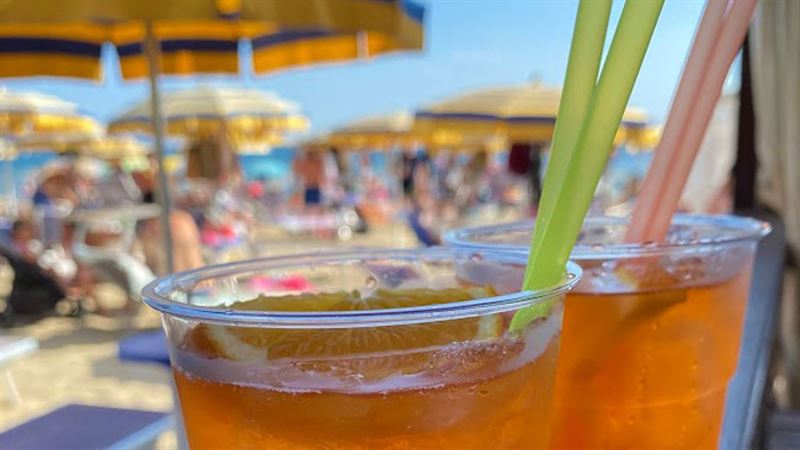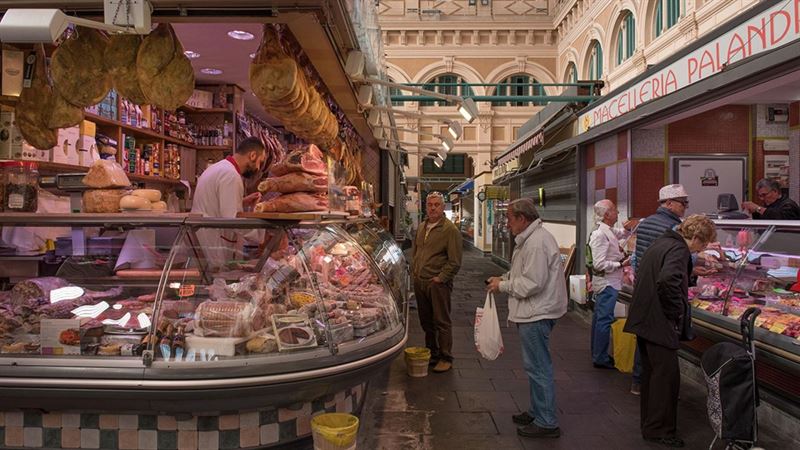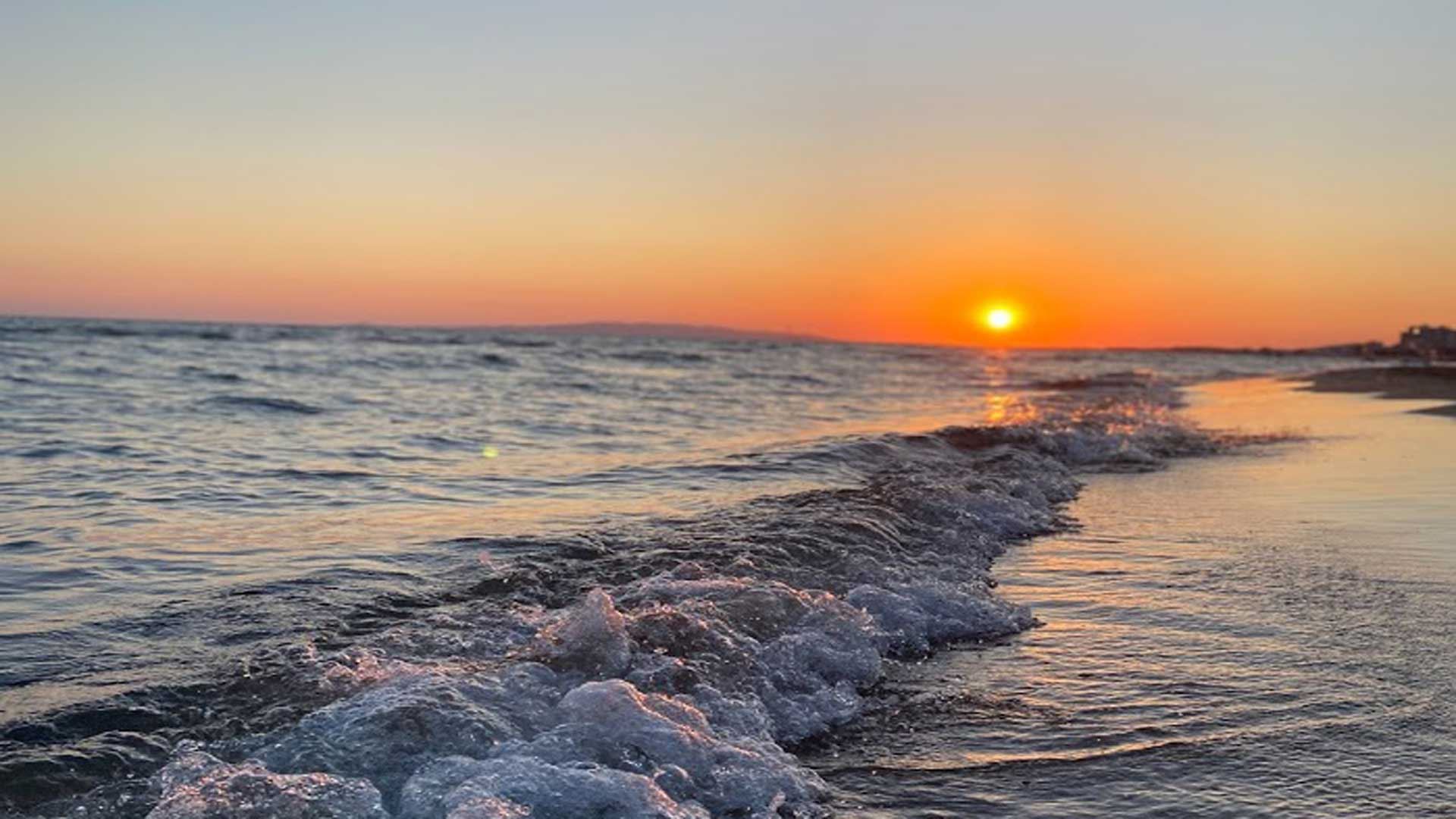In the annual `beach charts’ Tuscany triumphs. The region is recognised as having a superbly clean coastline, second only to Liguria’s. The beaches score highly for cleanliness of the water, safety, quietness, eco-friendliness and sustainability. Beaches are rated according to the trustworthy Blue Flags system. The sheer number of accredited beaches in Tuscany confirms the wisdom of opting for a beach break here. Not that it will ever be `just’ a beach break. What’s brilliant about the Tuscan coast is the proximity of beguiling art cities, hilltop towns and Etruscan sites. Yet given the length of the coastline and the competing claims presented by the cities of art in the hinterland, it’s best to decide on a couple of connecting coastal areas and to explore around there. Combine a villa-holiday near Viareggio with forays to Lucca and Pisa. Or, say, combine the beach at Castiglione della Pescaia with hiking in the Maremma.
The Tuscan Coast
-
-

Top Ten Things To Do
These are our Top Ten Things to Do, from basking on beaches to dolphin-watching, from cycling the seafront to visiting coastal nature reserves. Unlike many destinations, in Tuscany you can combine culture and the beach. Just don’t attempt to cover the entire coast on one trip. Choose your base carefully.
If you want to visit the classic cities of art from your seaside base, bear in mind that these are mostly more accessible from the northern coast, notably the Versilian Riviera. Typical day trips would be to Pisa, Lucca, Pistoia or Florence. Instead, if you’re based on the southern coast, in the Maremma, close to Grosseto, then Siena makes the most logical day trip, reachable in well under two hours.
The coast ranges from partying resorts to family-friendly beaches and deeply secluded bays. The northern coast, the Versilian Riviera, tends to be more manicured while the Maremma, the southern coast, is wilder and more romantic. In between stretch sweeping sandy bays, often backed by pine groves.
On the Versilian Riviera, to the north, the resorts range from posing Forte dei Marmi to boisterous Viareggio, a sun-and-sand resort popular with Italian families. Just south, closer to Pisa, are smaller, family-minded, highly affordable resorts along the Pisan Riviera (Riviera Pisana). Continuing south leads to the Etruscan Riviera (Riviera degli Etruschi). This, the Livorno coast, reveals a series of smaller resorts with sandy beaches and nearby ruins of Ancient Etruscan sites. Just south lies Grosseto province, bordered by the Maremma coast, the gateway to the wild Maremma region. Along this lovely stretch of coast, fun-loving Follonica, chic Punta Ala and Monte Argentario have all confirmed their Blue Flag beach status. Overall, Tuscany boasts 19 locations. -
1. Hit Tuscany's Best Beaches
Tuscan beaches deliver both romance on the rocks and the regimented lines of beach umbrellas that most Italians confuse with seaside bliss. The northern (Versilian) coast tends to be more manicured while the southern (Maremma) coast is wilder and more romantic.
In Forte dei Marmi, the Versilian Riviera boasts the best-known resort for the chic set. Just south, Viareggio remains the most popular big beach resort in Tuscany. In the Maremma, the best beaches include family-friendly Castiglione della Pescaia, remote Marina di Alberese, and most of the chic Monte Argentario peninsula’s Silver Coast (Costa d’Argento).
The best of the best beaches?
For secret coves and a wilder, more dramatic coastline you need to head south to the largely undeveloped Maremma and rocky Monte Argentario. The turquoise sea is the most translucent you’ll find in Tuscany beyond the true islands of Elba and Giglio.
The romantic, rocky cove of Cala Piccola, on Monte Argentario, arguably has the most aquamarine waters. Yachties will prefer to swim off swanky Porto Santo Stefano and glitzy Porto Ercole. The best beaches needn’t be the wildest. To see-and-be-seen, join the swish summer scene at Forte dei Marmi or the low-key luxe of Punta Ala. As for privacy and a back-to-nature remoteness, little beats Marina di Alberese, within the Parco della Maremma.
Beach Tips
Be ready for the deckchair-to-deckchair style of many beaches, especially in the bigger resorts on the Versilian Riviera. For most non-Italians, the beaches tend to have a regimented feel but there are huge compensations. The “ultra-organised” beaches are ultra-organised in a good way, too.
Families can have fun, even doing their own thing, from beach volleyball to beach tennis or safely playing in a dedicated kids’ club. No one gets bored. The beaches tend to be child-friendly and well-run, with plentiful lifeguards. Not that adults are forgotten. Some beach clubs might even have a spa or a peaceful, adults-only pool, or a private pier for sunbathing without the hordes. And there’s always a profusion of Italian beach-posers to watch.
The beach bars and seafood restaurants generally serve decent food: Tuscans wouldn’t put up with anything less. In smarter resorts or beach clubs it can extend to sushi or international favourites. And, if you’re bored, there’s often free WiFi to pass the time while topping up your tan.
At bigger resorts, the beachfront is mostly divided into stabilmenti, or bagni, bathing establishments where you can hire cabanas, sun-loungers and parasols but are still not quite true beach clubs. In these bigger resorts, such as Viareggio, it’s often worth going in the afternoon and negotiating a discount on the sun-loungers. At the other end of the scale, for a taste of the highlife, head to Forte dei Marmi, which boasts the chicest beach clubs in Versilia.
Discover the Versilia Riviera (northern coast)
In Versilia, the current resorts awarded Blue Flags include beaches close to bustling Viareggio and fashionable Forte dei Marmi. The neighbouring resorts of Massa and Carrara regularly confirm their healthy beach status. Backed by mountains, the beaches are overshadowed by elemental Tuscany, a stark contrast to cosseted Forte dei Marmi. Close to Viareggio, Torre del Lago Puccini offers clean, free beaches, wide stretches of sand fringed by pine groves.
Other Blue Flag beaches along the Versilian Riviera include Marina di Pietrasanta and good-value Lido di Camaiore. The contemporary pier in Lido di Camaiore is perfect for promenading and taking in the sunset over a drink. Marina di Pietrasanta offers plenty of sandy beaches, a mix of free and paying, and is the resort belonging to arty Pietrasanta, a renowned sculpture capital. This is the Tuscan centre for stone sculptors, who come here in droves to work the marble, ever since the days of Henry Moore and Joan Mirò. As a result of all this artistic intensity, a fine white dust cov¬ers everything in Pietrasanta, even the wineglasses in the bars of the Piazza Carducci.
In Versilia, the beaches tend to be wide, with sweeping sands lapped by fairly shallow water, and manned by plentiful lifeguards. As the Versilia coastline lacks rocky inlets, it’s particularly suitable for young children or unconfident swimmers. Even so, given the short-shelving Tyrrhenian coast, it can go from shallow to deep pretty fast.
Discover the Pisan Riviera (from Pisa to Livorno)
If you dream of regimented beach games, then the resorts around Viareggio are for you. If, instead, you want to escape the beach-tennis and deckchair-to-deckchair intensity of typical Italian beaches, then head south. The Pisan Riviera, a short stretch of coast between Pisa and Livorno, lies just south of Viareggio. The Riviera Pisana offers a mix of low-key beach resorts and beaches framed by pine groves.
East of Pisa, the dunes of the Migliarino-San Rossore nature reserve (www.parcosanrossore.it) provide proof that you’ve escaped the enforced jollity of beach-tennis. On the edge of the nature reserve awaits unpretentious Marina di Pisa, the seaside escape for Pisans. Marina di Pisa is a Blue Flag beach, as are the family-friendly Tirrenia-Calambrone beaches that follow.
Discover the Etruscan Riviera (Livorno to Piombino)
Known as the Riviera degli Etruschi in Italian, the clue’s in the name – this coast harks back to the times of the Etruscan metal-workers. Near Piombino, behind the sweep of Baratti Bay, lie the ruins of Populonia. This was the last of the 12 Etruscan cities to be founded. The Etruscans very considerately had them¬selves buried by a pine-fringed beach, reason enough to visit the only Etruscan city built on the coast.
The Etruscan Riviera runs from Livorno to the promontory of Piombino, from where you can catch a ferry to Elba. The coastline is rocky until Castiglioncello but then opens up into a seemingly endless series of sandy bays, including Marina di Cecina and Marina di Bibbona.
Discover the Maremma Coast & Monte Argentario
South of the Etruscan Riviera lies the Maremma, the wilder, southern part of the coast. Blue Flag beaches abound, from chic Punta Ala to tiny beaches and secret coves around the Monte Argentario peninsula. Stars include Castiglione della Pescaia’s Pineta del Tombolo, a sandy beach fringed by pine groves, just south of Punta Ala. Here, swimming is optional but preening is essential, preferably at a beach club.
North of sought-after Punta Ala, facing the island of Elba, is brash, family-friendly Follonica, with its pristine sweep of sands. Further south, beyond Castiglione della Pescaia, lies Grosseto, with its underrated, ultra-clean beaches. Two favourite Blue Flag beaches there are Marina di Grosseto and Principina a Mare. Further south, around the Orbetello lagoon and the Monte Argentario peninsula, await some of Tuscany’s best Blue Flag beaches. Get ready to bag a spot on one of the many small beaches around Porto Santo Stefano and Porto Ercole, such as Le Viste or La Feniglia. Punta Ala and Monte Argentario may be the resorts for socialising and being seen, but most Maremma beaches are for low-key nature-lovers. -
2. Combine the Versilia Coast and Apuan Alps
Tuscany’s northern corner is one of its wildest, loveliest, yet least explored areas from the Versilia Riviera to a dramatic landscape of pine-covered mountains, craggy ravines, remote villages and marble peaks. It’s hard to get more than a glimpse of this wilderness on a day trip but it’s still worthwhile as it’s such a contrast to the coast. And all this with the famous beach resorts of Forte dei Marmi and Viareggio attached.
Versilia is renowned for its sociable beach resorts, which range from sophisticated Forte dei Marmi to fun-loving Viareggio. Whereas Forte dei Marmi is the resort for socialising and being seen, Viareggio is for everyone. This coastal region lies west of Lucca, squeezed between the Apuan Alps in the east, and Lake Massaciuccoli in the south.
Leave the coast at Marina di Massa, a popular resort, with fine wide sandy beaches, pine groves and a promenade of pastel-shaded villas. Towering over the coastal lowlands are snow-capped mountains and terraced hillsides, an untamed terrain riven by deep gorges. Michelangelo built a road from the marble quarries to load the marble on waiting ships – and inadvertently created a summer playground. Once pine-covered, the coast is largely built-up but in place of rustic charm it offers fine seafood, a sense of fun, and beach entertainment, Italian-style – all against the backdrop of the Apuan Alps.
Massa is only 12km north of Forte dei Marmi, with Carrara just 3 km further. both are working towns, not monuments to marble. Even so, Marina di Carrara still ships marble all over the world. Although mainly modern, Massa has a well-preserved medieval centre, with a cluster of narrow winding streets. At its heart stands the medieval Duomo, which boasts a baroque in¬te¬ri¬or and, of course, a modern marble façade. Carrara is more overtly carved out of marble but has little to offer beyond the marble museum. The Museo del Marmo recounts the story of marble from Roman times to today. Displays include varieties of ¬marble and granite, plus explain the great leap from hammer-and-chisel quarrying to a high-tech industry. Otherwise, the main evidence of the famous marble quarries in Carrara is the river of white mud that flows through the town, which has a dusty, disaffected air about it.
If feeling adventurous, explore the marble quarries in Carrara’s Marble Mountains (in Forte dei Marmi guide). This is Tuscany at its most wild. If in search of cultural stimulation, leave the coast for the closest art cities. Foremost among these are Pisa, Lucca, Pistoia or Florence.
Address: Museo del Marmo, Viale XX Settembre 85, Localita Stadio, Carrara
Tel: 0585 845746 -
3. Beach-life in Forte dei Marmi
Beach-lounging is big business in Forte dei Marmi. Framed by the Apuan Alps, this swish resort is made for swimming and strolling and there’s even a stretch of dunes. Patches of beach are freely accessible, while the remainder is made up of smart bathing huts and tropical-style bars, perched on the fine pale-grey sand. The gently sloping shore means bathing is safe. Italian-resort-style, the sea is mostly reached by paying an entrance fee. Regimentation rules so expect to lie on a sunbed among rows of others, on sand carefully raked and flattened.
For the smart set, summer in Forte dei Marmi is highly ritualistic, with a consensus about which beach, beach club and cocktail bar is the most desirable spot. Not that you have to follow the crowd. One of Versilia’s most fashionable nightspots is Flavio Briatore’s Twiga Beach Club, between Forte dei Marmi and Marina di Pietrasanta. Here, passing celebrities down cocktails on the beach before dancing the night away in this chic club. The smart set can book a massage, dine on seafood or resolutely French bubbles. Over-priced and over-hyped, with hip DJs, the club is international rather than Italian but it delivers what is expected. Beach Club del Principe Forte dei Marmi is another cocooning beach club, with the equally exorbitant Ristorante Dalmazia serving such delights as stir-fried shrimps, baked seabass, grilled rock-octopus, or Jerusalem artichokes with black truffles – all on the Principe’s private beach, of course. Bagno Angelo (on via Arenile, T: 0584 82050) is a more affordable beach establishment. If you don’t want to pay the inflated prices of Forte dei Marmi, simply head to Viareggio, further down the coast. While there, sip reviving drinks in the historic Gran Caffe Margherita on the seafront.
See our full Forte dei Marmi guide for more. If looking for cultural stimulation, head away from the coast to the closest art cities. Foremost among these are Pisa, Lucca, Pistoia or Florence.
Address: Twiga Beach Club, via Roma 2, Lungomare, 55042 Forte dei Marmi
T: 0584 21518
W: https://www.twigafortedeimarmi.com/en/
Beach Club del Principe Forte dei Marmi, Hotel Principe, Viale Morin 67, 55042 Forte dei Marmi
T: 0584 784145
W: www.principefortedeimarmi.com -
4. Riviera Degli Etruschi - Livorno and the Etruscan Riviera
The Etruscan Riviera (Riviera degli Etruschi or Costa degli Etruschi) runs from Livorno to the promontory of Piombino, where the Etruscans were once based. Captured in moody canvases by the Tuscan Impressionists, the rocky northern coast is as dramatic as the southern coast is soothing. The coastline is rocky until Castiglioncello but then opens up into a seemingly endless series of sandy bays, including Marina di Cecina and Marina di Bibbona before reaching Piombino. The coast is no architectural desert: a coastline of Pisan watchtowers and Medicean fortresses hides the occasional Roman villa or Etruscan necropolis.
As for Livorno, it’s a slow burn. Although shabby and understated, Livorno boasts a cosmopolitan past and the best seafood in Tuscany. As Italy’s second largest port after Genoa, it owes its existence to the silting up of Pisa in the 15th century. The Livornese joke that, unlike their rivals, the Pisans, they will never be so careless as to let the sea slip away from them. The rivalry between Pisans and Livornese is legendary and very much alive today.
The Medicean port is unchanged. The red-brick Fortezza Vecchia is a patchwork of Livornese history, featuring Roman remains, medieval Pisan walls and a Romanesque tower. The Fortezza Nuova, built in 1590, completed the Medicis’ ambitious fortifications. The murky canals encircling it once led to Pisa. Now restored, the New Fortress is landscaped as a park and serves as a stage for summer festivals. The other main attraction is neighbouring Piccola Venezia, dubbed `Little Venice’ for its criss-crossing canals.
From Livorno to Castiglioncello the route hugs the cliff’s edge and reveals scenic views as it dips in and out of tunnels. The locals are fond of the rocky resort of Castiglioncello, preferring it to the slightly monotonous sands below Cecina. Cosimo de’ Medici’s fort, built on the pine-clad promontory, was designed to keep the pirates at bay.
The Etruscan Coast ends with ferry port of Piombino, set on the same peninsula as a major Etruscan settlement. Behind the sweep of Baratti Bay lie the ruins of Populonia, the last of the 12 Etruscan cities to be founded. The Etruscans very considerately had themselves buried by a pine-fringed beach, reason enough to visit the only Etruscan city built on the coast. The ancient city was divided into two parts: the acropolis the religious centre clustered high around the village and the maritime and industrial centre around the bay. The necropolises cover the slopes between the two centres. Thanks to its proximity to Elba and to the metal-bearing hills on the mainland, Populonia became a rich industrial city. While iron ore from Elba was smelted and then traded within the Etruscan League, minerals from Campiglia were shipped to Corsica, Sardinia and France. Now tourists are shipped to Elba.
L'Osteria Fonte del Penitente
Set in a former monastery, this slightly out-of-the-way restaurant serves superb seafood, including cacciucco alla livornese (fish stew).
via di Montenero 345, 57128 Livorno
T: 0586 579481
W: www.fontedelpenitente.com -
5. Maremma drive to Massa Martimma
Follonica is a cheap-and-cheerful summer resort, often dubbed the Miami of Tuscany. That said, it makes a handy base for visiting the hilly hinterland, including Massa Marittima, the loveliest town in the area. A thirty-minute drive north-east deposits you close to Massa’s spectacular Piazza Garibaldi, one of the finest squares in Tuscany. Medieval Massa prospered from copper and silver mines exploited since Etruscan times. Despite its decline after the mines failed, the town has preserved its gorgeous medieval core, gracious palaces and authentic regional restaurants.
From here it’s a fifty-minute drive back to the coast at Castiglione della Pescaia. With its medieval citadel and cobbled streets, this charming resort is not a hidden secret but still makes an appealing base. Its wine shops remind you that some of Tuscany’s best wines are made nearby. Time can stand still when lunch unfolds over a wild boar stew and a bottle of Bolgheri red wine.
From here, it’s a twenty-five-minute drive west to Punta Ala. The resort occupies one of the most prestigious promontories in Tuscany, rivalled only by Monte Argentario further south. With its sleek yachts in the marina, Punta Ala is as secluded and cosseted as anywhere on the coast. Its appeal lies in the sense of privacy and luxury. It feels like a life bound by glades of pines, racing yachts and private tennis clubs. Chic restaurants sit in the shadow of ancient watchtowers. Shaded by palms and umbrella pines, you have little to do but ponder the next seafood lunch or watch the spinnakers of yachts in the straits between the promontory and Elba. From here, it’s a twenty-minute drive along the coast, back to Follonica.
Address: Massa Marittima tourist office, via Todini 5, 58024 Massa Marittima
Tel: 0566 906554
Web: https://www.turismomassamarittima.it/ -
6. Maremma - on foot, horseback or canoe
The pristine Maremma coastline is awash with secret coves, pine groves and piratical castles. From Castiglione della Pescaia, the landscape becomes wilder on the SP 158 east to Alberese, the gateway to the Parco dell’Uccellina. As the last virgin coast on the Italian peninsula, Tuscany’s most beguiling park is deeply precious. The landscape ranges from salt marshes, sand dunes and open plains to whale-backed hills, sheer cliffs, pine forests and Mediterranean maquis, perfumed scrubland.
Long-horned Maremman cattle might wander into the picture but the tough cowboys and their stocky horses keep a low profile. Waymarked paths wind past parasol pines and coastal dunes to steep cliffs and a shoreline dotted with Spanish watchtowers. Trails, designed for all ability levels, wind through the pine groves and rosemary-scented scrubland. Instead, from Talamone, at the far end of the park, you can explore the coast by canoe.
Activities within the nature park include canoeing on the Ombrone river, sailing along the coast, riding across the mountains, bird-watching by the salt marshes and visiting the noble ruins of San Rabano and other towers strung out along the mountain tops, overlooking the sea. Each tower has its story of marauding pirates and hidden treasures, going back to the times of the Saracens and Spanish galleons.
Parco dell’Uccellina (also called Parco Naturale della Maremma), Alberese or Talamone visitor centres, 58100 Alberese.
www.parco-maremma.it
T: 0564 407098 (general)
T: 0564 393238 (booking guided walks).
Tuttomaremma.com: 0564 813635 & www.tuttomaremma.com -
7. Monte Argentario drive, swim and lagoon feast
Further down the coast is Monte Argentario, a law unto itself. In fact, from 1556 until 1815, Argentario existed as a separate state from the Grand Duchy of Tuscany, under Spanish rule. The craggy peninsula of Monte Argentario is, by turns, stylish, wildly romantic, and cut adrift. Unlike in Forte dei Marmi further north, here you can `see and be seen’ one day, disappear the next.
Once an island, Monte Argentario gradually became attached to the mainland by two long sandbanks, Tòmbolo della Giannella and Tòmbolo di Feniglia. Like two outstretched arms, the sandbanks hug a strange lagoon, a wintering spot for migrating birds. Both sandbanks have fine beaches, but Feniglia is best, backed by protected pine forest. It’s a 7km walk or bike ride to the mainland.
On Monte Argentario, the beach scene is more about hidden coves than broad beaches – the terrain is too rocky for proper beaches. Lap up the yachtie hangouts of Porto Santo Stefano and Porto Ercole, including the secret coves that lie between them. Blue Flag beaches include those around Porto Santo Stefano beaches: Il Pozzarello, La Soda, Cala Piccola, La Caletta and Il Moletto.
Orbetello, a fishing town set on the isthmus, was once a Spanish garrison town. It is now a backwater, with the sea lapping the bastion walls. Lovers of lagoon fish and smoked eel should still try I Pescatori, overlooking the moody lagoon, and run by a gruff fishermen’s cooperative.
Porto Ercole, on the eastern shore of Monte Argentario, was once a sleepy fishing village but has morphed into a bustling sailing base and diving centre. Forte Stelle is the most compelling of the defensive fortifications ringing the port, and is the only 16th-century fort open to visitors.
Its sister port, Porto Santo Stefano, is a stepping stone to the island of Giglio but also marks the start of `La Panoramica’, the panoramic drive along the Monte Argentario coast. From the shadow of the Spanish castle in the port, the scenic coastal road winds along the cliff-tops, with spectacular views of the Tuscan archipelago at every turn. At its best, Monte Argentario offers the Tuscan mainland’s only approximation of Sardinian-style marine paradise.
Address: Porto Santo Stefano 35, Grosseto 58019
Tel: 0564 813635
Web: www.tuttomaremma.com -
8. Bagni di Pisa - For revitalising hot spings
If suffering from a surfeit of beach-life in Versilia, consider a day out at Bagni di Pisa, the most appealing and upmarket day spa close to the coast. Set in San Giuliano Terme, 40 km south of Forte dei Marmi, the spa is close enough to the coast to combine a spa outing with a coastal stroll and seafood feast around Marina di Pisa. The charmingly faded spa town of San Giuliano Terme lies midway between Pisa and Lucca, at the foot of the Pisan moun¬tains. Olives, chestnuts and pines grow nearby, while wild horses roam the hills. San Giuliano is renowned for the curative powers of its thermal springs.
Here, Bagni di Pisa spa resort is the best place to try out a thermal spa treatment, or simply indulge in some pampering. In its heyday, this atmospheric spa resort played host to the Romantic poets but is still romantic without them. These spa waters have been celebrated since Roman times and are especially good for the treatment of rheumatism and arthritis. Montaigne, Byron and Shelley were famous Grand Tourists who swore by such treatments. Even without any ailments, come for a day spa experience. Wallow in the hot springs and indulge in a treatment or two, including in a grotto pool. The spa experiences include lunch or dinner at the romantic Dei Lorena restaurant, with a distant view of the Leaning Tower of Pisa. Alternatively, consider a return to the coast at Marina di Pisa for a seafront stroll or a seafood dinner. (For more, see the Marina di Pisa route in our Pisa guide). -

Eating & Drinking
On the coast, the most typical dishes are cacciucco alla livornese (fish stew) and cinghiale dolce forte (sweet-and-sour wild boar). Neighbouring Maremma is a meaty, macho region, serving up wild game with boar, hare or pheasant. This area also boasts some of Italy’s most famous wines, such as Super Tuscans produced around Bolgheri. Also try the Morellino di Scansano DOC, a full-bodied red wine, obtained mostly by Sangiovese and Ciliegiolo grapes.
The single most famous dish is from coastal Livorno, which produces the delicious cacciucco, the filling fish stew claimed to be the original bouillabaisse. The story goes that the soup originated in the port after a fierce storm left a widowed fisherman’s wife desperately trying to feed her many children. The children were sent begging for something to eat. As the fishermen had nothing else to give, the children came home with handfuls of mussels, a few shrimps, half a fish and some fish heads. The clever mother put them all in a pot, added herbs and tomatoes from her garden and created cacciucco. While zuppa di pesce can be eaten all over Italy, cacciucco can be eaten only in Livorno and surrounding areas. It is ladled over a thick slice of toasted bread flavoured with garlic. -
Beach Club del Principe Forte dei Marmi
The pricey, cocooning beach club goes hand in hand with the equally pricey Ristorante Dalmazia. Enjoy such delights as stir-fried shrimps, baked seabass, grilled rock-octopus, or Jerusalem artichokes with black truffles – all on the Principe’s private beach, of course.
Address: Hotel Principe, Viale Morin 67, 55042 Forte dei Marmi
Tel: 0584 784145
Web: www.principefortedeimarmi.com -
Il Piccolo Principe
This theatrical Michelin-starred restaurant finds favour with visitors and locals alike, thanks to its rooftop setting and the cuisine itself. The menu blends international gourmet dishes with more local favourites, with pricey tasting menus centred on meat or seafood. Specialities include roast scallops, crab-stuffed ravioli, beef tartare and roast pigeon.
Address: Piazza Giacomo Puccini, Grand Hotel Principe di Piemonte, 55049 Viareggio
Tel: 0584 401806
Web: www.ristoranteilpiccoloprincipe.it -
Il Caffè Principe
Set close to Piazza Marconi, Caffè Principe is a perennially popular café made for people-watching. It sits on its laurels but remains a favoured spot for the smart set, at any time of day. The café can take you from breakfast to nightcaps. Come for a breakfast brioche, an Aperol Spritz or an affogato al caffè (a dessert made by dunking vanilla ice cream in espresso coffee) but prepare to pay over the odds.
Address: Caffe Principe, via Carducci 2, 55042 Forte dei Marmi
Tel: 0584 89238
Web: www.principefortedeimarmi.com -
L’Osteria Fonte del Penitente
Set in a former monastery, this slightly out-of-the-way restaurant serves superb seafood, including cacciucco alla livornese, the classic Livorno fish stew.
Address: Via di Montenero 345, 57128 Livorno
Tel: 0586 579481
Web: www.fontedelpenitente.com/ -
Il Moletto
On Monte Argentario, watch the ferries slip over to Giglio while feasting on grilled seabass, cuttlefish soup, all washed down with an Antinori white wine. Sit on the marina main drag in this mid-priced spot and maybe share a tiramisu or trifle to finish.
Address: Via del Molo 52, Porto Santo Stefano
Tel: 0564 813636 -
La Fontanina
Set in the hills a few minutes from Porto Santo Stefano, this inn serves beautifully presented food on its panoramic terrace. Tuck into Tuscan T-bone steak, baked sea bream, shrimp risotto, Maremma cheeses, with produce also from their own herb garden, orchard, vegetable gardens and olive groves. There are plenty of Maremma wines to be sampled.
Address: Localita San Pietro, 58019 Porto Santo Stefano
Tel: 0564 825261
Web: www.lafontanina.com -
Il Gambero Rosso
Set on Monte Argentario, this portside veranda restaurant serves Tuscan seafood with a view. Service is friendly while prices are very good-value for classic seafood platters and say, spaghetti with clams (vongole).
Address: Lungomare A Doria 70, 58018 Porto Ercole
Tel: 0564 832650 -
I Pescatori
Seafood-lovers should appreciate this rough-and-ready spot, overlooking the moody lagoon, and run by a fishermen’s cooperative. They’re specialised in lagoon fish, which is an acquired taste but ocean fish are also on the menu. Try the good-value menu or such dishes as grilled seabass or grey mullet roe, paired with austere Ansonica white wine.
Address: Via Giacomo Leopardi 9, 58015 Orbetello
Tel: 0564 860611
Web: https://ipescatoriorbetello-centrodegustazione.it/ -
La Porta
Set in a beamed, sixteenth-century townhouse by a clocktower, this is an unfussy rustic inn with an open fireplace and a terrace with sea views over the hills. On offer are traditional Maremma dishes, ranging from game (boar) to spit-roast meats, ricotta-stuffed ravioli, and Tuscan T-bone steak.
Address: Via V Emanuele, 58011 Capalbio
Tel: 0564 896311
Web: www.ristorantelaporta.com -

Shopping
Punta Ala and Forte dei Marmi are the resorts for designer shopping, including around Punta Ala’s sleek marina. For fun, browse Forte’s Wednesday market on Piazza Marconi for everything from mink coats to stylish bed-linen and swimwear, or top designer fashion to fakes. In summer there’s an additional Sunday market, held on the same square. If peckish while shopping, grab crunchy snacks of foccaccia or `pizza a taglio’ (pizza by the slice) from Da Valé, a popular bakery (Piazza Garibaldi 4, Forte dei Marmi, T: 0584 89361). Unlike Forte, Viareggio offers a broader range of everyday shopping, even if there’s plenty of designer shopping, too.
-
Profumeria Walchiria
This Art Nouveau, retro-style perfumery doesn’t seek to dazzle with designer scents but with niche fragrances. The knowledgeable proprietor willingly weaves spells around the perfumes, recounting the history of their creation and matching the right perfume to the right client.
Address: Piazza Massimo d’Azeglio 62, 55049 Viareggio
Tel: 0584 45069
Web: www.walkirialaprofumeria.com -
Super-Tuscan wine route
Shopping in much of Maremma is wine-related. This is shopping `on the hoof’ in the form of wine trails. Sassicaia, Ornellaia, Grattamacco and Le Macchiole are among the best of the Costa degli Etruschi’s so-called Super Tuscans. Many estates welcome visitors for wine-tasting and vineyard tours. At Cecina, south of Castiglioncello, take the inland road to medieval Bolgheri, a pocket of the Maremma fashionable for the Super Tuscans. These include the highly prized Sassicaia, Ornellaia and Solaia. To many wine experts, this is the future of Tuscan winegrowing.
-
Rocca di Frassinello
In Maremma, one wine star is Rocca di Frassinello, a blend of Sangiovese, Cabernet and Merlot, a wine with the elegance of Bordeaux and the robustness of Tuscany. The winery, likened to “a flying carpet landing on rolling hills,” is designed by Renzo Piano, Italy’s `starchitect’. After touring the cellars, sip these fine wines, as princely as the best Bordeaux.
Address: Localita Poggio alla Guardia - Giuncarico Scalo, Gavorrano (Maremma/Grosseto)
Tel: 0566 88400
Web: www.castellare.it -
Parking
Most Tuscan towns operate a strict ZTL system, a Limited Traffic Zone. This means that the Centro Storico (historic centre) is essentially closed to traffic, particularly for non-residents. Cars will need to be left outside this zone. Forte dei Marmi’s ZTL covers a larger area in summer so expect more restrictions then. That said, coastal parking is generally more straightforward than in Tuscany’s art cities and medieval hill-towns.
Advice on ZTLs:
You may see other cars crossing the ZTL boundary (Limited Traffic Zone) and assume you can proceed. Not so. The drivers crossing into the ZTL zone will probably be locals and have residents’ permits. Visitors do not so are liable to fines. Zones are monitored by cameras, so tickets are issued immediately and automatically, as soon as (and each time) the car crosses the ZTL boundary.
Forte dei Marmi provides easier parking options than do many Tuscan towns, except at peak periods. Parking is in short supply during the regular Wednesday morning market and during the seasonal Sunday morning market. Good parking options are generally on the seafront, around Viale Italico (free) and (paying) on Viale della Repubblica. (See Forte dei Marmi guide for more).
Viareggio provides easier parking options than do many Tuscan towns, except at peak periods. You might well find parking close to the main promenade but it tends to be paid parking (mostly running from 8am to 8pm). Alternatively, there are park-and-ride car parks (with free bus links) close to the sea and the main promenade. (See Viareggio guide for more).
For more on transport in Viareggio (and also Lucca Province in general), contact Mover: T: 0584 427021 and www.moverspa.it
Punta Ala is very strict about parking, especially in high season. See the advice below:
http://www.marinadipuntaala.com/en/content/parking-areas -
Getting there & getting around
Getting there: If you’re arriving in Viareggio from the A12 motorway, leave at the Viareggio-Camaiore exit. Make your way onto the Aurelia SS1 road, following signs to a convenient car park, such as Largo Risorgimento.
By car:
From Viareggio it’s only a 14km drive (or cycle ride) to Forte dei Marmi. Pisa is around 23km south while Lucca is around 28km west and Florence is 110 km distant but a manageable drive for a day trip. In the Maremma, on the southern coast, Siena is the most obvious big city attraction.
By train:
Viareggio station is set on the western edge of the city. It’s on the Florence-Lucca line and reasonably well-connected.
By bike:
At the main car parks, such as Largo Risorgimento, you can find free bikes, linked to a handy local bike-sharing scheme you can sign up to (via MO.VER, via Regia 4 - 55049 Viareggio, T: 0584-427021 & www.moverviareggio.it)
You can cycle to Forte dei Marmi, Marina di Pietrasanta and Lido di Camaiore. For details of cycling routes, check the Forte dei Marmi resort website and tourist office: (via Spinetti 14, 55042 Forte dei Marmi. T: 0584 28029 & www.comune.fortedeimarmi.lu.it)















